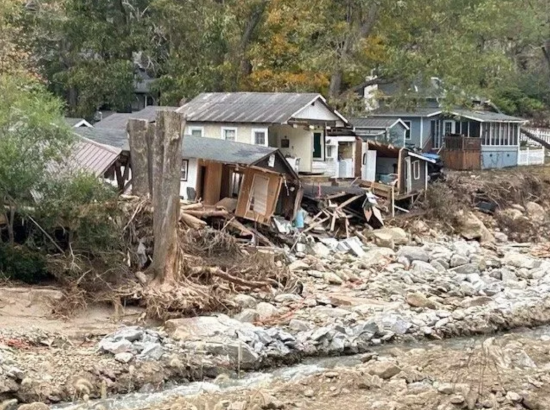Destruction of homes in Chimney Rock, North Carolina from Hurricane Helene
WLOS|Courtesy
With the peak of the Atlantic hurricane season hitting in October, the East Coast saw two hurricanes that left lasting damage in their paths. The first, Helene, made landfall in Florida on Sept. 26.
Helene’s damage stretched from Florida to Virginia, but the damage was most prominent in North Carolina.
The second, Milton, specifically impacted Florida, and made landfall on Oct. 9.
On “PBS NewsHour,” Asheville Mayor Esther Manheimer spoke after Helene’s damage subsided.
“The priority is to restore water and power. And, in the meantime, we have got to get resources to folks that need drinking water, food, and basic necessities for everyday life. So, that could be diapers, formula, all the things that you would think of that you need to live in your home,” Manheimer said.
Most affected areas are still in need of more relief efforts. Virginia Wesleyan is contributing by coordinating multiple different means of support. Director of Civic Engagement and Service Learning Bethany Tsiaras spoke on the matter.
“One of the biggest ones is donating blood. So we are going to have a blood drive as the Red Cross is coming on Nov. 7 from 11 a.m. to 4 p.m. in the CMAC,” Tsiaras said.
This drive will help provide blood for the Asheville area which is one of the items with the most demand post-hurricane. Usually overlooked for food and generators, the blood will help aid medical assistance which could save lives.
Another way that Virginia Wesleyan is getting involved is putting together supplies for a future trip in the middle of March.
“In partnership with Campus Ministries, we are working on sending supplies in a group during spring break. So that would be like an alternative spring break option to go along with the blood drive,” Tsiaras said.
If someone wants to help out, outside of efforts sponsored by Virginia Wesleyan, there are other factors often considered. Transportation, housing and food are frequently the biggest constraints to civilians committing themselves to relief.
“So you would sign up with an organization to go and be in that area. We are not encouraging [anyone] to self deploy, that is very dangerous. You want to sign up with a reputable organization that’s already going, which is what myself and Marie [Porter] would do with a group of folks,” Tsiaras said. Tsiaras also said that anyone interested in the spring break trip should reach out to her at btsiaras@vwu.edu.
Another way that Virginia Wesleyan is assisting those affected by the hurricane is offering students at nearby schools a transfer program.
“We have a wonderful transfer program here too. So if folks who are in college in affected areas have to transfer, or want to transfer to come here, we would welcome them here. That would obviously go through enrollment,” Tsiaras said.
The most heavily affected area by Helene was North Carolina. But after seeing the extensive damage Helene caused, more states took notice and took extra precautions for Milton. Head Olympic Sports Equipment Manager at Florida Atlantic University, Rayce Robbins, commented on the safety measures observed before Milton’s impact.
“The school I work at closed down classes for the week and only authorized personnel were on campus. The city started opening up shelters around town for incoming tourists because everyone had to flee Tampa and Tallahassee. Boca Raton actually advertised for people to evacuate surrounding towns and come to Boca [Raton] as the storm was coming from the west,” Robbins said.
The measures taken by the city and surrounding areas proved helpful according to residents.
“The proactive measures were pretty effective. A lot of people averted crises by coming here, as their homes got flooded on the west coast of Florida, so it definitely saved lives. People also boarded up their windows in my apartment complex, which did a great job at protecting the glass from debris,” Robbins said.
Both Hurricanes Helene and Milton have carved their paths into the country’s southeastern region, leaving a trail of destruction behind them. However, thanks to many national emergency response teams, community donations and surrounding support, the affected areas are moving forward in recovery.
By Crosson Miller


